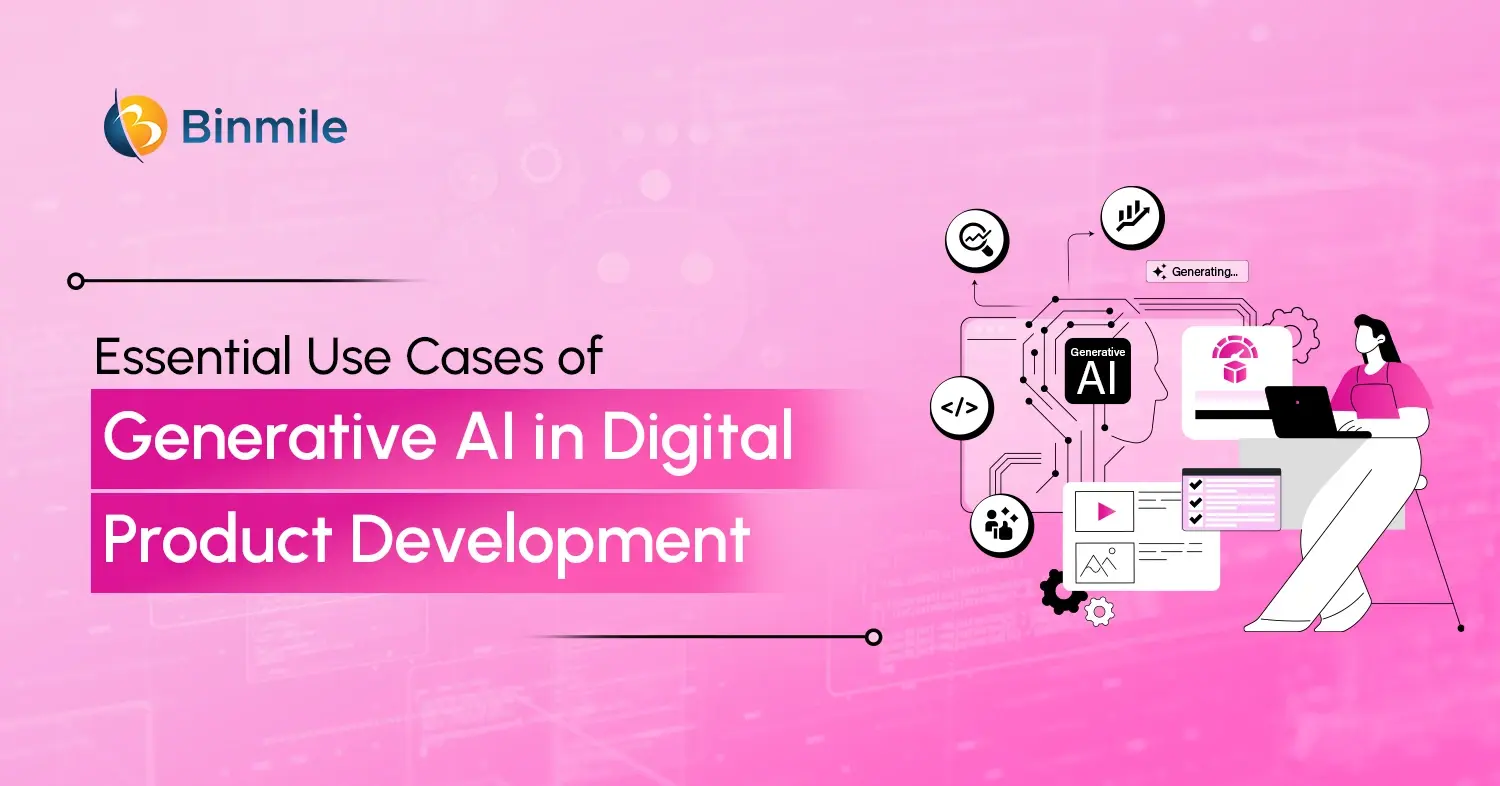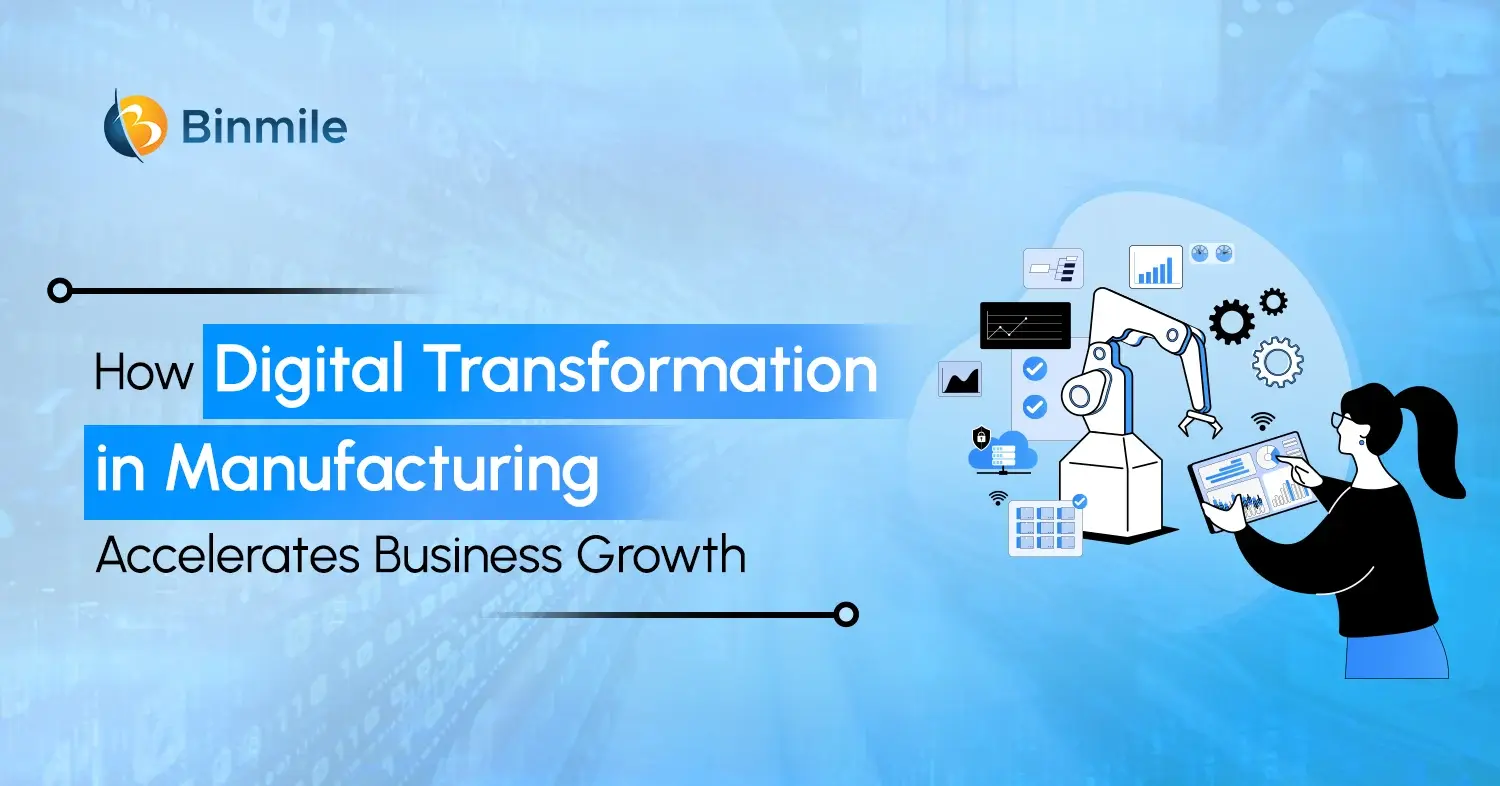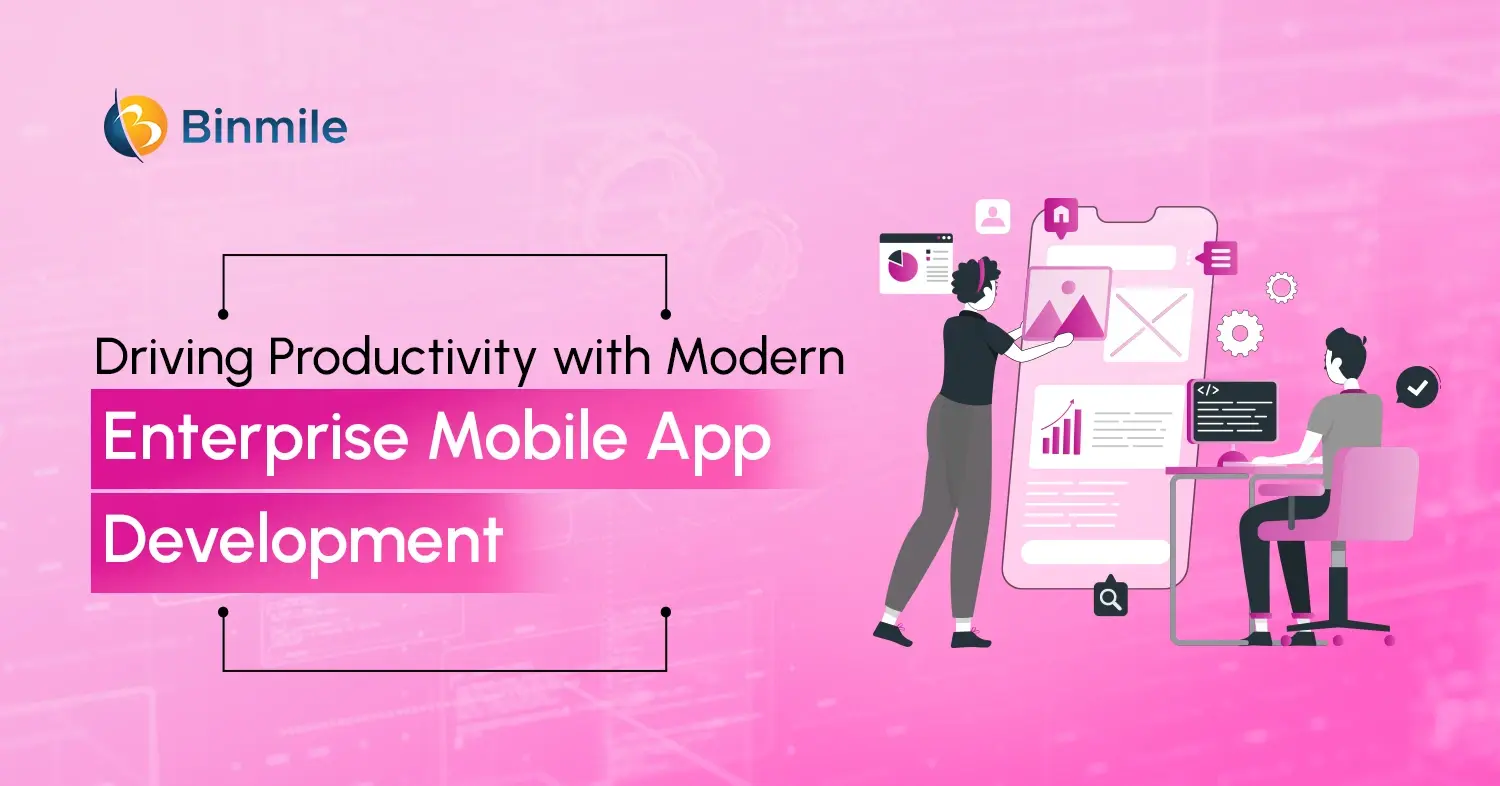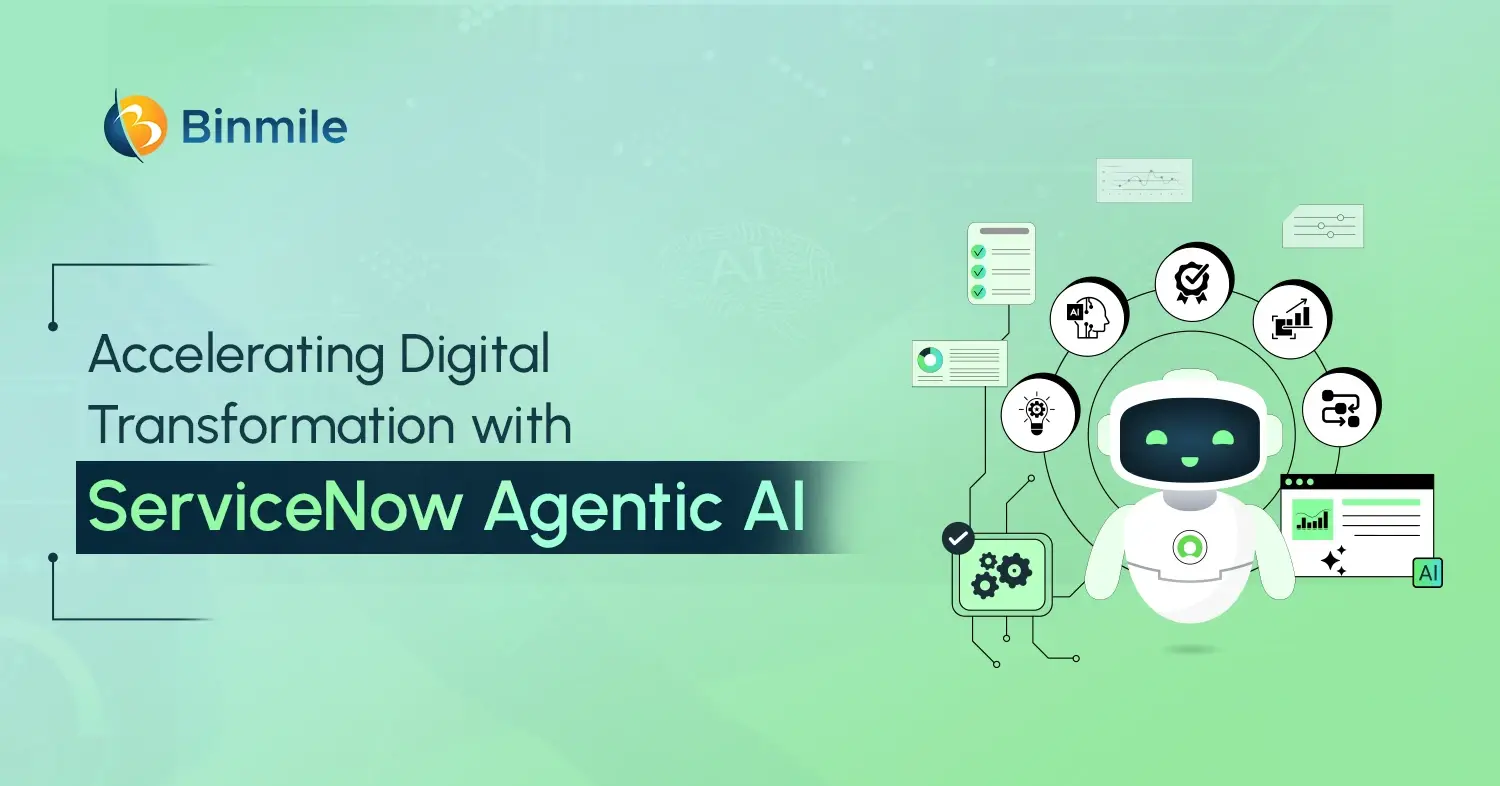Today’s businesses are under increasing pressure to innovate more quickly, provide better digital experiences, and control costs. According to a recent McKinsey report, generative AI has the potential to revolutionise the design, development, and scaling of products and boost the global economy by up to 4.4 trillion dollars annually.
This blog will discuss the top generative AI use cases that are already yielding benefits, how generative AI in digital product development is transforming innovation, what generative AI consulting means for businesses, and what businesses should consider when incorporating generative AI tools and platforms into their workflows. We’ll also examine realistic future trends and a fair assessment of how a technology partner can help with this sector’s digital transformation.
What is Generative AI Consulting in Product Development?
Businesses frequently believe that generative AI is limited to text, chatbots, or content production, but it has far more potential for developing digital products. The main goal of generative AI consulting is to assist companies in determining which generative AI solution best suits their objectives, where this technology fits into their product strategy, and how to operationalise it without endangering user experience, data quality, or compliance.
Capability assessments, model evaluation, cost analysis, and alignment with current software product development guide processes are usually the first steps taken by consulting teams. Many organisations are investigating generative AI in business for the first time and need clarification on models, infrastructure, governance, and security, which makes this support invaluable. With the correct direction, businesses can steer clear of creating features that are interesting but unusable or unscalable.
The Expanding Role of Generative AI in Digital Product Development
Teams working on digital products have advanced well beyond conventional AI. They now use generative AI in digital product development to produce completely new assets, designs, workflows, and product capabilities rather than depending solely on automation or predictive analytics.
Its function keeps expanding in areas such as:
- Idea generation and concept validation
- Software design and architecture planning
- Automated coding and testing
- Customer experience personalisation
- Product performance optimisation
- Documentation and knowledge management
Because AI models help with research, design suggestions, UI flows, and functional mapping, businesses that use generative AI for faster prototyping frequently see a significant reduction in development cycles. As a result, there are fewer iterations and increased innovation velocity throughout the product development lifecycle.
Top Generative AI Use Cases for Enterprises
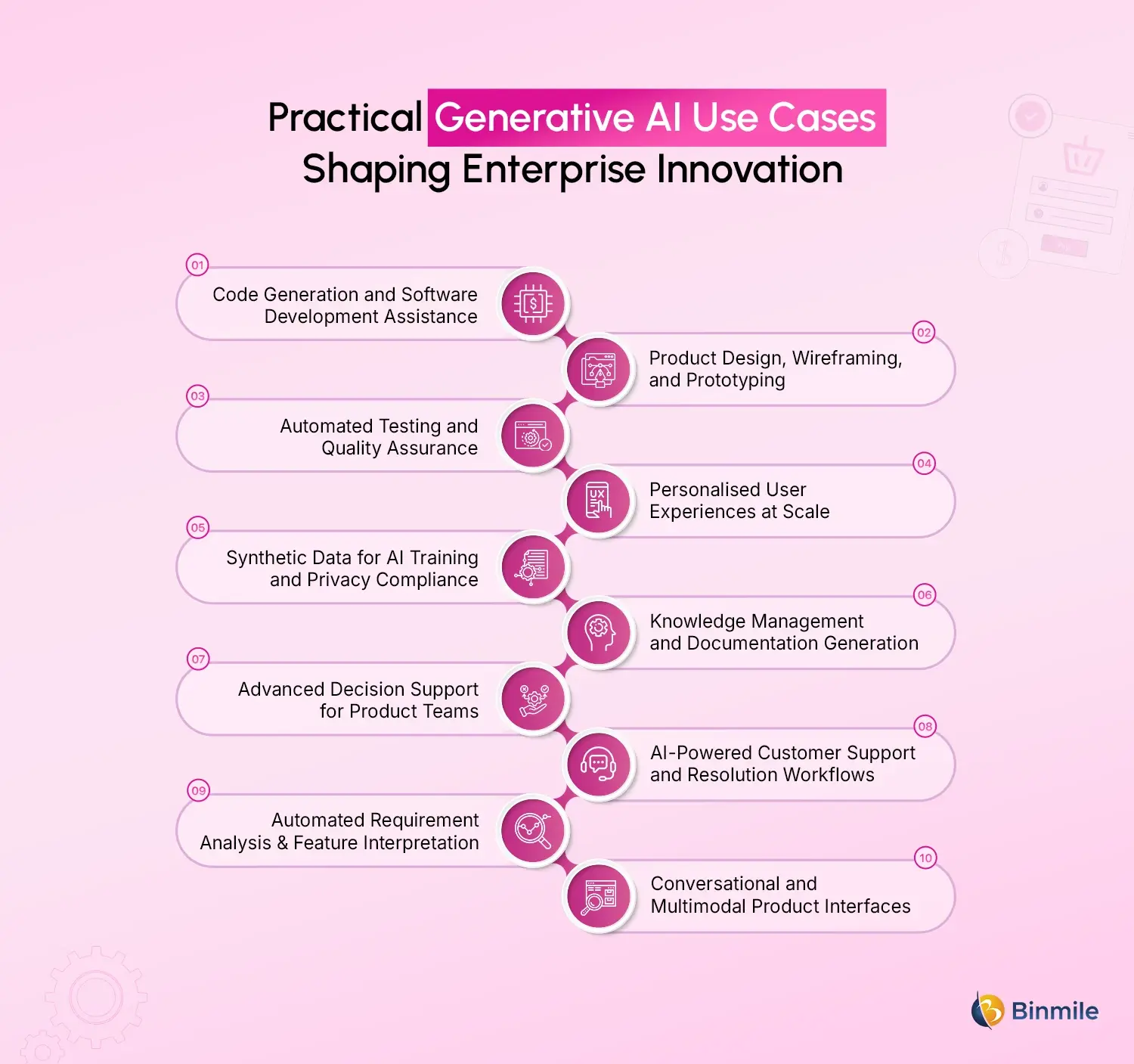
Below are the most relevant generative AI use cases that are actively transforming enterprise digital product development across multiple industries.
1. Code Generation and Software Development Assistance
One of the most common enterprise use cases for generative AI in digital product development is in the software development process. Boilerplate code can be automatically generated by AI-assisted development, which can also suggest improvements and optimal logic patterns. This minimises manual labour and saves time for engineering teams.
In order to facilitate tasks like code refactoring, debugging, test writing, and documentation generation, numerous businesses are incorporating generative AI platforms into their development pipelines. Because common errors are detected early, this improves code reliability in addition to speeding up delivery.
2. Product Design, Wireframing, and Prototyping
Generative AI tools can produce experience maps, user flows, product design elements, and UI mockups. Teams can receive complete design concepts that are easily refined after submitting brief prompts or feature descriptions.
This speeds up the ideation phase of generative AI in product development and lessens the need for drawn-out discovery sessions. The creative direction is still set by designers, but AI enables them to test more variations in less time and scale ideas more quickly.
3. Automated Testing and Quality Assurance
One of the most time-consuming steps in the development of a software product is testing. By creating test cases, anticipating failures, and automating regression test scripts, generative AI can significantly lessen this load.
Higher coverage is guaranteed by AI-supported QA, which also identifies problems that human testers might overlook. Businesses using large applications or systems with frequent feature updates will find it especially helpful.
4. Personalised User Experiences at Scale
Generative AI is used for personalisation by businesses in a variety of industries, including telecom, healthcare, retail, and BFSI. It produces in-app instructions, chatbot responses, FAQs, recommendations, and customised content.
With auto-drafted responses, generative AI in the telecom industry enables customer support teams to provide faster resolutions. AI improves patient engagement in industries like healthcare by providing individualised insights and streamlined medical advice.
Nowadays, personalisation is more prevalent in digital product journeys and product development choices than it was in marketing.
5. Synthetic Data for AI Training and Privacy Compliance
Businesses that handle sensitive data are using synthetic data as a safe substitute for training models. Generative AI produces realistic datasets without disclosing private or sensitive data.
This maintains privacy compliance while enhancing product performance. It is beneficial in sectors with stringent data protection regulations, such as finance, insurance, and healthcare.
6. Knowledge Management and Documentation Generation
Maintaining accurate documentation for complex software systems is a challenge for many businesses. Based on code and product updates, generative AI can automatically create internal wikis, release notes, feature descriptions, and user manuals.
This facilitates new developers joining projects without lengthy ramp-up cycles and enhances internal communication.
7. Advanced Decision Support for Product Teams
In order to suggest enhancements or new features, a generative AI guide in business operations can examine past data, user behaviour, and product usage patterns. It serves as a helper that facilitates strategic planning and provides product teams with fast, data-driven insights.
8. AI-Powered Customer Support and Resolution Workflows
Support teams benefit from generative AI’s ability to efficiently classify tickets, identify user intent, and draft responses. It guarantees consistent support quality across sizable customer-facing platforms and expedites issue resolution.
In order to anticipate common issues, AI-powered support systems also examine past interactions. Businesses benefit from better product experiences and a lighter overall support load as a result.
9. Automated Requirement Analysis and Feature Interpretation
Product teams frequently work with unstructured data, including requirement documents, support logs, and user feedback. This data can be interpreted by generative AI, which can then turn it into precise feature requirements by identifying significant patterns.
This helps teams more quickly agree on the direction of the product and eliminates uncertainty in early planning. Additionally, it guarantees that user requirements are more precisely recorded throughout the development process.
10. Conversational and Multimodal Product Interfaces
Chat-based, voice-driven, and multimodal interfaces that improve product usability are made possible by generative AI. By comprehending text, audio, and visual inputs, these interfaces improve the usability and accessibility of digital products.
Businesses are utilising these features to create intelligent assistants, interactive onboarding processes, and in-product assistance. This increases overall product adoption and boosts user engagement.
Integrating Generative AI into Existing Product Development Workflows
Incorporating generative AI in digital product development involves not only a technological change but also a transformation of people and processes. For businesses to responsibly and extensively implement new AI capabilities, they require organised frameworks.
Key considerations include:
- Aligning AI features with real business goals
- Ensuring clean and reliable data input
- Building an agile environment for experimentation
- Selecting the right generative AI tools and generative AI platforms that support enterprise scale
- Auditing security, compliance, and model governance
- Training teams for AI-assisted workflows
- Establishing continuous monitoring and quality checks
Product managers, developers, designers, data scientists, and business executives must work together across teams to ensure a successful integration. The result is a well-coordinated strategy that combines AI-powered efficiency with human creativity.
Want to integrate Generative AI into your enterprise workflows without disrupting your existing systems?
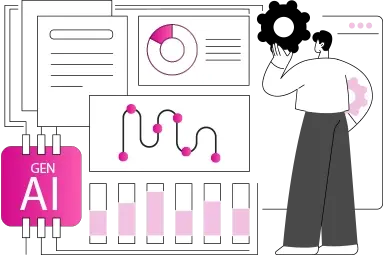
Emerging Generative AI Trends Shaping the Future

Using generative AI for enterprises today will see even greater advancements over the next few years. Some of the key future trends include:
1. Multi-agent AI systems
AI systems will work together to accomplish tasks on their own. Multi-agent systems that manage coding, testing, deployment, and performance monitoring will be very beneficial to software development.
2. Industry-specific generative AI models
Businesses will favour models that have been trained especially for manufacturing, e-commerce, healthcare, finance, or telecommunications. This increases precision and guarantees that the generative AI solution is more compatible with the product ecosystem.
3. Full lifecycle AI copilots
The entire software product development process, from ideation to post-deployment analytics, will be covered by AI copilots. For the engineering and product teams, this results in a more efficient workflow.
4. Voice and multimodal product interfaces
New interface designs that integrate text, audio, visuals, and interactions will be fueled by generative AI. This will have an impact on how businesses design and develop digital products.
Exploring Generative AI for your next digital product, and need clarity on where to begin?

How Binmile Can Support Your Generative AI Journey
As enterprises explore generative AI in digital product development, many discover that the most challenging part is not the model itself but the strategy, implementation, and long-term scaling. This is where an experienced technology partner becomes meaningful.
Top AI Consulting companies like Binmile help enterprises move from experimentation to real product value by aligning AI capabilities with business needs, integrating AI within existing architecture, and ensuring security and compliance. Their expertise in product development and AI development makes it easier for teams to adopt generative AI without slowing down operations.
Such partners guide enterprises in selecting the right generative AI platform, designing cost-efficient workflows, and setting up robust governance frameworks. They also assist in building custom enterprise-grade AI features that go beyond generic use cases. As a result, businesses gain faster innovation cycles, improved product quality, and a more intelligent digital ecosystem.
Frequently Asked Questions
Industries like telecom, healthcare, retail, BFSI, manufacturing, and technology services benefit the most, as their product operations involve large volumes of data, repetitive procedures, and a need for quick digital innovation.
The majority of AI applications fall into one of the six AI use case primitives. Classification, extraction, prediction, generation, dialogue, and clustering are some of them.
Yes, when strategically applied, it results in quantifiable return on investment by cutting down on development time, increasing productivity, improving personalisation, and lowering operating costs.
The first step is to perform an AI readiness assessment to determine objectives, data maturity, and the viability of incorporating AI into current systems.
Developers can concentrate on high-value tasks because it speeds up coding, aids in refactoring, improves debugging, produces documentation, and supports continuous testing.
The key elements are workflow integration, data quality, governance, model accuracy, security, team training, and long-term scalability.
